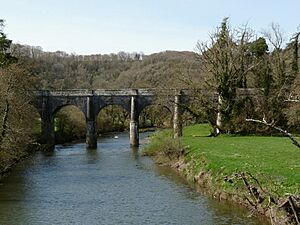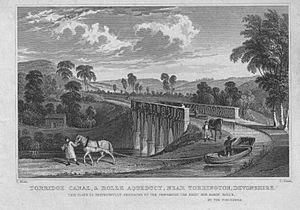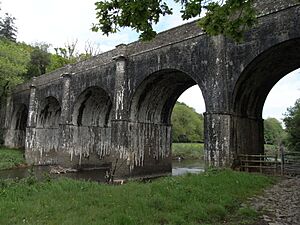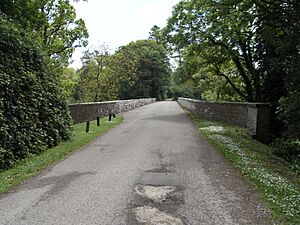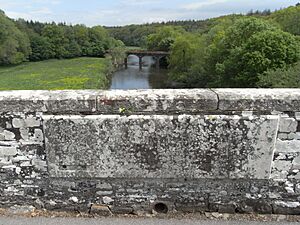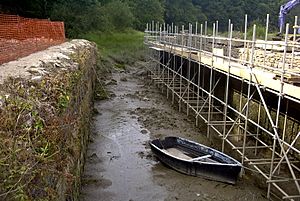Rolle Canal facts for kids
The Rolle Canal, also known as the Torrington Canal, is located in north Devon, England. It stretches about 6 miles (10 km) from the River Torridge at Landcross southwards. The canal was built to connect industrial mills and corn-mills in Great Torrington to the river. It also reached Healand Docks and a weir on the Torridge, where old lime kilns can still be seen. These mills were built by Lord Rolle and used water from a stream that also fed the canal.
Contents
What the Canal Looks Like
The Rolle Canal has several interesting features:
- A sea lock at Landcross. This is like a gate that helps boats move between the river and the canal, especially when the tide changes.
- A 60-foot (18-meter) inclined plane at Weare Giffard. Instead of using many locks to change height, boats were pulled up or down this ramp.
- An aqueduct with five arches over the River Torridge at Beam. An aqueduct is like a bridge that carries water, allowing the canal to cross over the river.
At the end of the canal, near the lime kilns at Rosemoor, there is a leat. This is a special channel that brings water from the River Torridge into the canal. It helps keep the water level constant. This leat gets its water from the Healand Weir, which was rebuilt in 1837.
Lime Kilns
The canal ends at a group of lime kilns at Rosemoor. These kilns were designed by James Green. They are made up of five large pots, each about 14 feet (4.3 m) wide and 20 feet (6.1 m) deep. They are lined up in a row along a wharf.
Small railway tracks led from the canal up a ramp to the top of these pots. This flat area was used to store limestone and fuel (like coal) before they were burned. An office for the foreman, who managed the site, was also located at the top. Today, these kilns are old and unused.
History of the Canal
Building the Rolle Canal began in 1823. It was a private project, mostly paid for by John Rolle, 1st Baron Rolle. He was a very wealthy landowner in Devon. His main home was Stevenstone, near Great Torrington. Lord Rolle owned a lot of land around Torrington, including the Beam estate.
The canal was built mostly without official permission at first. A special law was finally passed in 1835 to allow it. Lord Rolle's father, Denys Rolle, had thought of the idea for the canal much earlier, but it never happened.
The main reason for the canal was to bring limestone from Wales and coal to inland kilns. These materials were burned together to make lime fertilizer. This fertilizer was very important because it made farm land much more fertile and valuable. The canal also helped export Marland Clay, which was dug up south of Torrington, to make bricks. This clay was sent out through the seaport of Bideford.
More generally, the canal connected the industrial mills in Great Torrington, some of which Lord Rolle owned, to the seaport of Bideford on the River Torridge. James Green was the main engineer for the project.
Lord Rolle himself laid the first stone of the aqueduct in a special ceremony. A cannon was fired, but it accidentally exploded and injured a man named John Hopgood. Lord Rolle paid him a year's salary as compensation. A stone tablet on the Beam Aqueduct still has an inscription about this event.
The canal was finished in 1827 and cost between £40,000 and £45,000. It shared many design ideas with the Bude Canal, which had partly inspired it and used the same engineer. For example, both canals used special "tub boats" and inclined planes instead of many locks. The inclined plane on the Rolle Canal was powered by a water wheel. The canal got its water from a weir on the River Torridge, which also supplied water to two mills.
Leasing and Closure
Around 1852, about ten years after Lord Rolle passed away, the canal was leased to George Braginton. He was a local businessman and had been Lord Rolle's canal agent. After George Braginton's lease ended, control of the canal went to Mark Rolle, Lord Rolle's adopted heir.
In 1871, the canal was closed down. It was sold to the London and South Western Railway company. They wanted to use the canal's path to build a new railway line from Bideford to Torrington. The railway was eventually built, following parts of the old canal route. Later, in the 20th century, the railway was taken apart. Now, its path is part of the Tarka Trail cycleway, a popular route for walking and cycling.
Some parts of the canal can still be seen today. The Beam Aqueduct is still there, now used as a bridge for a new road to Beam Mansion, which is an adventure holiday center. The sea lock also remains, though its gates are gone. Parts of the inclined plane can also be seen. The Annery kiln, near Weare Giffard, is close to the old canal and visible from the Tarka Trail. The canal area is now recognized as a Devon County Wildlife Site, meaning it's important for local nature.
Restoration Efforts
The Beam section of the canal is still owned by the heir of Lord Rolle, Lord Clinton. It is managed by his family's company, Clinton Devon Estates.
Since 1988, parts of the canal have been undergoing restoration. Clinton Devon Estates plans to restore the Beam estate section of the canal. In 2000, they finished restoring an old stone bridge that used to carry a driveway over the canal. In 2006, some work was done on the sea lock, including repairing and rebuilding parts of its eastern wall.
The Canal in Stories
The Beam Aqueduct is mentioned in Henry Williamson's famous book, Tarka the Otter. In the story, it is called the "canal bridge."
Images for kids



